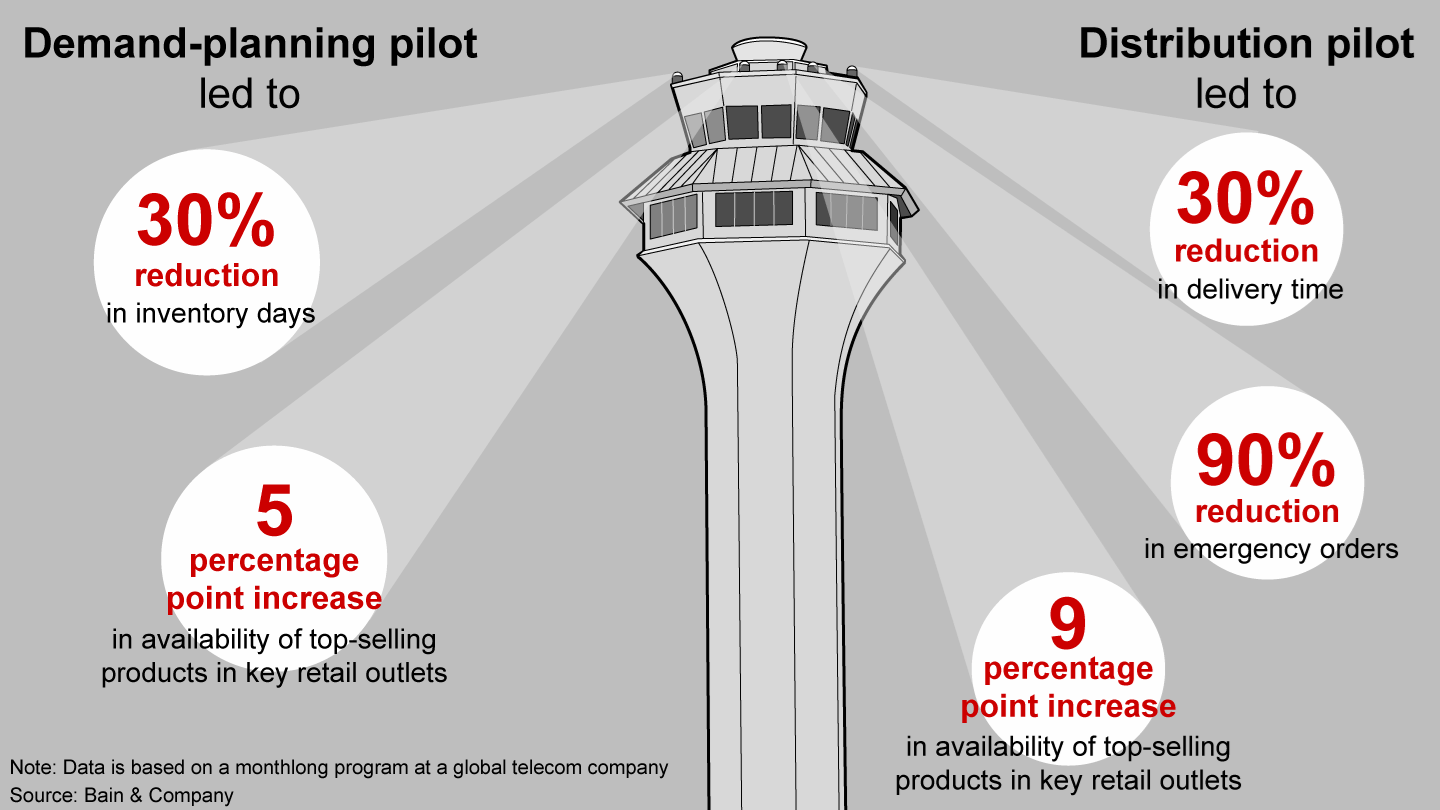Operations Excellence

Two senior executives walk into a room full of monitors and detect the trouble spots across the company’s global supply chain. One screen alerts them to a delayed raw material delivery that threatens to slow production and suggests three alternative courses of action. The next one warns that a machine on the production line needs urgent maintenance to avoid a possible breakdown and indicates where production could be relocated. On the other side of the room, a large screen shows trucks, ships and smaller vehicles moving toward delivery destinations, highlighting those that are behind schedule in red and noting whether the deliveries will meet customer needs.
That’s the kind of strategic information hub many leadership teams envision when they consider investing in control tower technologies. The promise is seamless, real-time visibility that improves decision making and performance. But supply chain control towers are still a work in progress. Many technology suppliers offer piecemeal solutions for parts of the supply chain—but none offers a complete, integrated view from sourcing to distribution, harnessing predictive analytics.
For many executives, taking the first steps forward can feel like walking an obstacle course in the dark. The market is full of conflicting information about what control towers can and cannot do. Companies that invest too quickly also risk adopting new solutions that won’t work with legacy information technology (IT) systems or each other. Typically, past investments have led to a patchwork quilt of specific technology solutions that can’t exchange information in real time with other systems.
Building a control tower that covers the entire supply chain is a huge strategic effort, but there’s no need to wait for the perfect solution. Leadership teams can lay the foundations for a future control tower in a series of logical steps that deliver immediate gains. Successful companies look beyond discrete IT solutions. They develop a strategy that incorporates business objectives, available technology, the company’s legacy technology, supply chain processes, and governance.
Many companies focus first on improving visibility in vital parts of the supply chain. With real-time data in hand, executive teams can then begin to optimize performance. Eventually, linked solutions and artificial intelligence provide companies with an end-to-end view of activity along the supply chain and a step-change in efficiency.
Take the case of a global consumer-packaged-goods company suffering from rising network costs and lack of visibility across the entire supply chain, especially in inventory and logistics shipments. A diagnostic revealed that the firm had a limited ability to prevent bad orders. The company had deployed a limited number of digital solutions in siloed operations, but they were not linked and didn’t provide a complete picture of supply chain activities in real time.

Operations Excellence
Companies with best-in-class operations have a strong competitive edge. Bain's insights on operational excellence help leadership teams transform supply chains, procurement strategy, and manufacturing capabilities into strategic weapons.
To address those problems, the leadership team developed a five-year roadmap to invest in digital technologies and link solutions together in a control tower. First, it tackled four areas that existing software could greatly improve, including network planning and shipment visibility, based on real-time data about the location of trucks, trains and boats. Next, the team rolled out solutions to reduce errors and increase the speed of billing and order management. The roadmap provided a path to build end-to-end visibility into the entire supply chain, reduce forecasting errors, improve customer service responsiveness and eliminate warehousing inefficiencies. All told, the leadership team forecast hundreds of millions of dollars in potential efficiency savings.
Though building a control tower takes time, well-designed roadmaps can deliver surprisingly quick gains. A global leader in wireless telecommunications designed an interim control tower focused on product portfolio and inventory management. It launched one pilot program to increase the availability of devices in retail outlets, and another to improve inventory management of more than 3,000 stock-keeping units. After one month, the demand-planning pilot had reduced inventory days by 30% and increased the availability of the firm’s top devices in better-performing retail shops by 5 percentage points. The distribution pilot reduced point-of-sale delivery time by 50%, slashed emergency orders by 90% and increased the availability of top products in retail shops by 9 percentage points (see Figure 1). Building on these successful first steps, the leadership team selected a provider for a long-term control tower solution.
Control tower solutions can quickly improve supply chain performance


In our experience, four principles help executive teams cut through the noise about control towers, focus the first critical investments and construct a well-designed roadmap.
Define key business objectives. Successful companies view control towers as a solution to a business problem rather than a technology implementation. Select five or six performance objectives that will deliver the greatest improvement in supply chain efficiency—such as improved visibility between order processing and inventory, or real-time tracking of the distribution fleet.
Set priorities. Identify the business problems that offer the company the greatest opportunity to increase value today using existing software solutions that are the easy to implement across the entire supply chain.
Take an agile and modular approach. Many control tower solutions are still built on enterprise-centric technology—the very technology that has resulted in disconnected supply chains. When selecting vendors, choose those that are able to adapt solutions over time or can be easily replaced. And expect the plan to change over time as technologies continue to evolve.
Embrace flexibility and new ways of working. Ensure that legacy processes are appropriately redesigned to take advantage of the software solutions you are installing.
Building a control tower that provides a complete picture of supply chain performance and optimizes processes in real time is a journey, not a quick win. But companies that build a strategic roadmap around a few high-priority business activities can start to benefit today from improved supply chain visibility and efficiency.
Abhijit Prabhu and Adam Borchert are partners in Bain & Company’s Performance Improvement practice. Both are based in the firm’s Boston office.